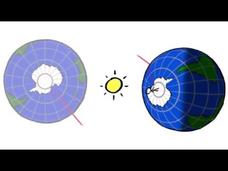PBS
The Sun and Planets
Do other planets experience night, day, and the seasons like humans do here on Earth? Examine planetary motion using real images of the planets through a simulation from PBS's Space lesson series. After observing the motion of each...
PBS
Eclipse Over America — Predicting Eclipses
It's easy to find out in today's world when the next eclipse will be, but what about thousands of years ago? Junior astronomers discover how the Babylonians used lunar observations to accurately predict future eclipses through an...
PBS
Global Ocean Currents
What forces drive the ocean's currents? Science scholars observe global ocean currents at different depths to explore their characteristics and patterns. Part of PBS's Weather and Climate series, the resource includes teaching...
PBS
The Calendar, Australia, and White Christmas
Could a white Christmas in July ever actually happen? PBS's series on space time and measurement presents a video discussing how our ideas about the seasons won't hold true forever! The narrator explains how Earth's gyroscopic behavior...
PBS
The Leap Second Explained
Everyone's heard of leap years ... but what about leap seconds? Young scientists get acquainted with one of humankind's most awkward standard measurements with a short video from a PBS playlist covering space and time...
Veritasium
Why Does The Earth Spin?
Is it really love that makes the world go 'round? Find out in an amusing interview-based video. The narrator asks visitors at a city park why Earth continues to turn on its axis. After several misguided attempts at invoking different...
MinutePhysics
What IS Angular Momentum?
Have you ever felt like you're going nowhere? You really are going nowhere — if you happen to be spinning, rotating, or orbiting something! Young physicists learn about angular momentum in a short illustrated video. The narrator...
MinutePhysics
Why December Has The Longest Days
What will you do with an extra 30 seconds? Scholars learn that December 22nd is 24 hours and 30 seconds long, which classifies it as the longest day of the year. An engaging video lesson analyzes Earth's orbit in combination with its...
MinutePhysics
What If the Earth Were Hollow?
Man has dreamed of outer space travel for hundreds of years...but, what about inner-Earth travel? Could it work? Young scientists explore the notion of jumping into a hole through Earth and the factors that affect the journey, such as...
MinutePhysics
The Tides
By watching the engaging video, young scholars learn the cause of tides and their effect on the earth and its rotation. The narrator explains the relationship between gravity and the location of the earth in relation to the moon and...
SciShow Kids
Why Can I See the Moon During the Day?
Ever wonder why the moon is visible during the day? Discover why with a captivating video that details the reason with the help from a lively host and engaging graphics.
Crash Course Kids
Seasons and the Sun
Discover the differences between summer and winter, besides coats and bathing suits, with a short and informative earth science video. Sabrina, the narrator of the animated video, talks about the ways the earth's tilt affects the...
Crash Course Kids
Earth's Rotation and Revolution
Where does the sun go at night? Don't worry, it's just facing the other side of the earth. Learn about Earth's axis, tilt, rotation, revolution, and what all this means for your summer vacation with an engaging earth science video.
Crash Course Kids
The Ecliptic
Where in the universe are we now? Teach your future astronauts and astronomers about the Ecliptic, the imaginary line that tracks the Earth's rotation throughout the year.
Scholastic
Study Jams! A Day on Earth
It's good thing that it isn't up to RJ to spin the earth on its axis; he can't even keep a basketball spinning! In this video animation, he and viewers learn about Earth's movements in space. One thing to consider before you use this...














